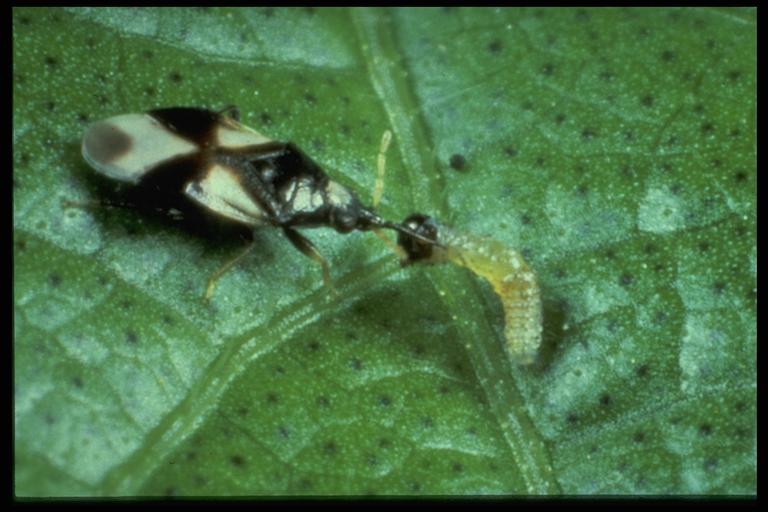
A minute pirate bug, Orius sp. (Hemiptera: Anthocoridae), attacking cotton bollworm. Photo by W. Sterling.
Common Name: Pirate bug
Scientific Name: Orius sp.
Order: Hemiptera
Description: Adults are tiny (1/8 inch) black bugs with white markings at the base of the front wings (hemelytra), resulting in a band-like appearance across the body when wings are at rest. Wingless immature stages (nymphs) are orange. Anthocorids are occasionally mistaken for chinch bugs, particularly in the early nymphal stages.
Life Cycle: Adults overwinter in protected habitats such as in leaf litter. Female Orius sp. insert eggs into plant tissue. Nymphs develop through several stages (instars) before becoming winged adults.
Habitat, Food Source(s), Damage: Nymphs and adults prey upon a wide variety of arthropods including aphids, chinch bugs, springtails, plant bugs, thrips, eggs and small larvae of corn earworms, whiteflies, spider mites. Sucking mouthparts are inserted into prey and body fluids are removed. When corn earworm eggs are plentiful, Orius sp. eat about one egg per day. They are important natural enemies of pests of many agronomic and horticultural crops including corn, cotton, sorghum, soybeans. They may also feed on tender plants. Anthocorids can be found on many kinds of plants, particularly agricultural crops, where they can be abundant. Some Orius species are sold commercially for augmentive biological control releases.
Pest Status: Considered beneficial; nymphs and adults prey on a number of small arthropod life stages; capable of using their sucking mouthparts to bite humans. The insidious flower bug, O. insidiosus (Say), is often the more abundant species in east Texas.
For additional information, contact your local Texas A&M AgriLife Extension Service agent or search for other state Extension offices.
Literature: Bohmfalk et al. 1982; Henn and Weinzeri 1990; Kogan and Herzog 1980; Slater and Baranowski 1978; Swann and Papp 1972.